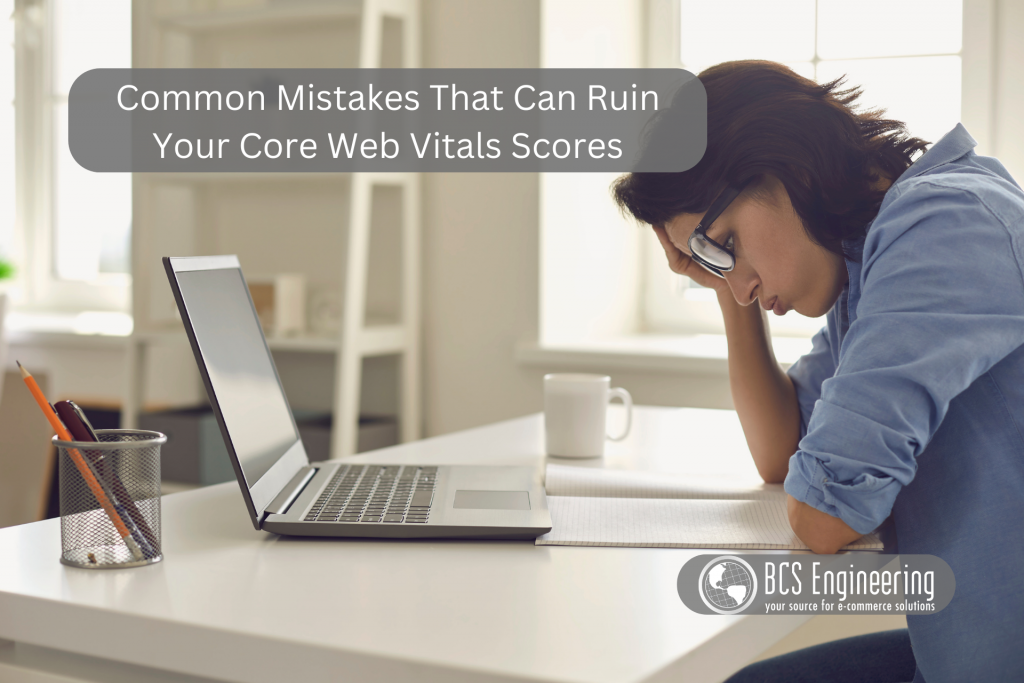When it comes to your site’s Core Web Vitals, it can be frustrating trying to figure out how to improve your site’s score. There are so many areas that could be causing problems, where do you even start? Lucky for us, there are some common mistakes that negatively impact your site’s Core Web Vitals that we can fix first!

What are Core Web Vitals?
Core Web Vitals are a collection of metrics created and tracked by Google. These metrics measure multiple aspects of the user experience on websites, measuring things like speed, accessibility, best practices, and Search Engine Optimization (SEO.) Think of it like a health checkup for your site!
Why are Core Web Vitals Important?
Measuring and improving your site’s Core Web Vitals not only helps your site perform better, but also can increase your rank in Google search queries. Google includes these metrics into the search query criteria with the goal of showing quality sites first.
Common Website Mistakes to Avoid
When it comes to your Core Web Vital scores, there are many things that can bring your score down. However, there are a few common mistakes that, if fixed, can increase your Core Web Vitals scores all around!
Using too many Plugins & Add-Ons
While plugins, add-ons, and analytics tools can enhance the functionality of your website, they can also negatively impact your Core Web Vitals in multiple ways. Each plugin and add-on you incorporate to your site needs resources to run. If you have too many plugins and add-ons, your site’s loading times will be slowed down, decreasing your site’s performance score. Certain kinds of plugins can also cause your page to shift around if your loading times are heavily impacted. Overall, it is best to use only the plugins and add-ons you need and to make sure that those they are loaded after the visible aspects of your page have appeared.
Not Optimizing your Images
Having large images and too many images on a page can heavily impact the speed of your site. Large images take more resources and time to load. One of the most common places we find large images is on the front page of a website. The banner image can often slow websites down a lot, negatively impacting not only your site’s performance, but user experience as well. Having multiple images can lead to the same scenario. To avoid this issue, make sure to size your images based on what you need. Many images can be resized and exported at less than perfect quality and still look great!
Using too many Fonts
Fonts are an important aspect of your website. Depending on the types of fonts you use and how many you incorporate into your website, both performance and accessibility can be negatively impacted. Custom fonts with large, unoptimized font files can affect load times as your site tries to unpack and illustrate them to your users. The same situation can happen when requiring your site to unpack multiple fonts at once. Best practice wise, keep your fonts simple and avoid using too many fonts on your site. Simple fonts not only are better optimized, but are easier for all of your customers to read.
Not Prioritizing Above the Fold Content
Above the Fold Content is the content your user sees first when arriving at your webpage. For many, you may think of your site’s home page when you think of above the fold content. The first things your user may see are a banner, site menu, call to actions, and some information about your site in. However, what loads first? You have to be careful when it comes to loading your front page and make sure that the content your user sees first loads first. Plugins, large banner images, resizing, and loading other elements first can slow down your site, negatively impacting your site’s performance. Make sure to optimize your above the fold content with fast loading elements while having the rest of your font page load after.
Using a Heavy Theme for your Site
When designing your website, choose your site theme wisely. Themes include all sorts of assets to make your site stand out but can be too heavy to load quickly. Assets such as images, videos, CSS styles, and JavaScript libraries all make up a theme, and if many of these assets are large, they can significantly slow down the loading speed of your web page. Use simpler themes when possible and try to optimize your theme if needed through compressing and optimizing some of the large assets it contains. “Lazy Loading” non-critical parts of your themes can also help!
Want to Learn More?
When it comes to improving and maintaining your site’s Core Web Vitals, we highly suggest making a routine out of checking them! Download our free Core Web Vitals Checklist to learn how you can measure your Core Web Vitals, understand the metrics, and improve your them!
